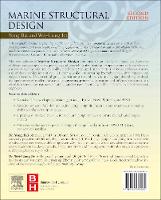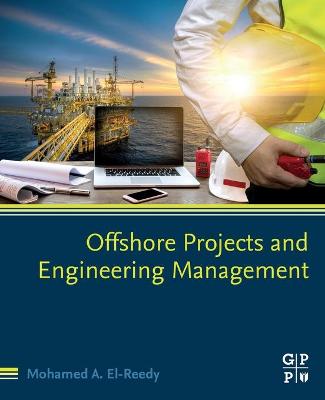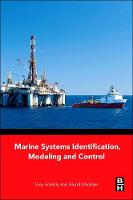Marine Structural Design
 -10%
portes grátis
-10%
portes grátis
Marine Structural Design
Jin, Wei-Liang; Bai, Yong
Elsevier Science & Technology
10/2015
1008
Dura
Inglês
9780080999975
15 a 20 dias
2140
Descrição não disponível.
Part I: Structural Design Principles 1. Introduction 2. Wave loads for ship design and classification 3. Loads and dynamic response for offshore structures 4. Scantling of ship's hulls by rules 5. Ship hull scantling by analysis 6. Offshore structural analysis 7. Limit-state design of offshore structures
Part II: Ultimate Strength 8. Buckling/collapse of columns and beam-columns 9. Buckling and local buckling of tubular members 10. Ultimate strength of plates and stiffened plates 11. Ultimate strength of cylindrical shells 12. A theory of nonlinear finite element analysis 13. Collapse analysis of ship hulls 14. Offshore structures under impact loads 15. Offshore structures under earthquake loads
Part III: Fatigue and Fracture 16. Mechanism of fatigue and fracture 17. Fatigue capacity 18. Fatigue loading and stresses 19. Simplified fatigue assessment 20. Spectral fatigue analysis and design 21. Application of fracture mechanics 22. Material selections and damage to tolerance criteria
Part IV: Structural Reliability 23. Basics of structural reliability 24. Random variables and uncertainty analysis 25. Reliability of ship structures 26. Reliability-based design and code calibration 27. Fatigue reliability 28. Probability and risk based inspection planning
Part V: Risk Assessment 29. Risk assessment methodology 30. Risk assessment applied to offshore structures 31. Formal safety assessment applied to the shipping industry 32. Economic risk assessment for field development 33. Human reliability assessment 34. Risk centered maintenance
Part II: Ultimate Strength 8. Buckling/collapse of columns and beam-columns 9. Buckling and local buckling of tubular members 10. Ultimate strength of plates and stiffened plates 11. Ultimate strength of cylindrical shells 12. A theory of nonlinear finite element analysis 13. Collapse analysis of ship hulls 14. Offshore structures under impact loads 15. Offshore structures under earthquake loads
Part III: Fatigue and Fracture 16. Mechanism of fatigue and fracture 17. Fatigue capacity 18. Fatigue loading and stresses 19. Simplified fatigue assessment 20. Spectral fatigue analysis and design 21. Application of fracture mechanics 22. Material selections and damage to tolerance criteria
Part IV: Structural Reliability 23. Basics of structural reliability 24. Random variables and uncertainty analysis 25. Reliability of ship structures 26. Reliability-based design and code calibration 27. Fatigue reliability 28. Probability and risk based inspection planning
Part V: Risk Assessment 29. Risk assessment methodology 30. Risk assessment applied to offshore structures 31. Formal safety assessment applied to the shipping industry 32. Economic risk assessment for field development 33. Human reliability assessment 34. Risk centered maintenance
Este título pertence ao(s) assunto(s) indicados(s). Para ver outros títulos clique no assunto desejado.
Accidental loads; Aerospace; Aging failure; ALARP-Principle; Analysis; Applications; Arctic offshore; Arctic region; Ballast water; Beam-column elements; Beam-columns; Bilinear Si?1/2N curves; Brittle fracture; Buckling analysis; Buckling coefficient; Buckling; Bulkheads; Calibration; Cargo; Certification; Classification rules; Classification society; Classification; Code calibration procedures; Collapse analysis; Collision analysis; Collision consequence; Collision risk; Collision; Columns; Combined loads; Composite material; Compressive stress; Concepts; Corrosion defects; Corrosion; Crack detection; Crack growth; Crack measurement; Crack; CTOD design curve; Cycle; Cycle-cost design; Cyclic loading; Damping; Dead loads; Decommission; Deepwater foundation; Deflection analysis; Deflection; Design codes; Design factors; Development; Differential equations; Ductility; Durability; Dynamic response; Dynamic; Eccentric axial compression; Effectiveness cost; Efficiency; Emission; Environmental loads; Equations; Error reduction; Escalation analysis; Estimation; Evaluation; Exploration; Fabrication tolerance; Fabrication yard characteristics; Failure assessment diagram; Failure mode; Failure modes; Failure propagation; Fatigue assessment; Fatigue damage; Fatigue; FEM approach; Ferry Borgesi?1/2Castanheta; Fiber; Finite element analysis; Finite element method; Floating structures; Floating; Force; Fracture mechanics; Fractures; Full immersion zone; Functional loads; Gaussian distribution; Geometric imperfections; Gradual failure; Green ship; Greenhouse gas; Green-water loads; Grounding; Hasoferi?1/2Lind; Hazard identification; Hazardous; Hazards; Health & Impact assessment; Hull girder collapse; Hull girder; Hull; Hydrocarbon explosions; Identification; Impact mechanics; Impact; Initiation; Innovation; Inspection data; Inspection strategies; Jacket platforms; Jacket structure; Large displacement plastic analysis; Limit safe; Limit-state design; Liquefied natural gas; Live loads; Load combination; Load; Loading conditions; Loadings; Loads; Lognormal distribution; Lognormal format; Management; Maritime industry; Material tests; Mechanical resistance; Membrane; Mobile infrastructures; Modeling; Moment interaction; Moment; Nominal stress; Nonlinear ship response; Nonlinearities; Nonlinearity; Numerical analysis; Offshore platforms; Offshore soil geotechnics; Offshore strength assessment; Offshore structures; Offshore time-depended reliability; Operation; Orthotropic; Plastic deformation; Plastic design; Plastic node method; Plasticity; Plate aspect ratio; Plate panels; Plated structures; Pollution; Power generation industry; PRA; Primary failure; Probabilistic distributions; Probability; Process systems; Production; Propagation; Propeller radiated signatures; Quality survival; Quantification; Rational analysis procedure; Rational stress analysis; Rayleigh distribution; RCM; Reliability updating; Reliability-centered maintenance; Repair events; Residual stress; Resin; Resistance; Response surface method; Risk and reliability applications; Risk assessment; Risk communication; Risk management; Risk matrices; Risk reduction; Risk-based approaches; Risk-based assessment; Risk-based classification; Risk-based decision-making; Risk-based inspection; Risk-based inspections; Risk-based management; Risk-based survey; Safety check; Safety factors; Safety integrity level assessment; safety; SANDY; Scantling; Sea loads; Sea states; Seabed corer equipment; Secondary failure; Seismic loads; Shear capacity; Shear Stress; Shell structures; Ship design technology; Ship life cycle; Slamming; Si?1/2N approach; Si?1/2N curves; Spectra; Splash zone; Standards; Static; Stiffeners; Storage and offloading (FPSO)Floating; Storage and offloading units (FPSOs)Asset integrity management; Stress concentration; Stress modeling; Stress; Stressi?1/2strain curves; Structural dynamics; Structural reliability; Sudden failure; System failure; Tertiary failure; Time fatigue
Part I: Structural Design Principles 1. Introduction 2. Wave loads for ship design and classification 3. Loads and dynamic response for offshore structures 4. Scantling of ship's hulls by rules 5. Ship hull scantling by analysis 6. Offshore structural analysis 7. Limit-state design of offshore structures
Part II: Ultimate Strength 8. Buckling/collapse of columns and beam-columns 9. Buckling and local buckling of tubular members 10. Ultimate strength of plates and stiffened plates 11. Ultimate strength of cylindrical shells 12. A theory of nonlinear finite element analysis 13. Collapse analysis of ship hulls 14. Offshore structures under impact loads 15. Offshore structures under earthquake loads
Part III: Fatigue and Fracture 16. Mechanism of fatigue and fracture 17. Fatigue capacity 18. Fatigue loading and stresses 19. Simplified fatigue assessment 20. Spectral fatigue analysis and design 21. Application of fracture mechanics 22. Material selections and damage to tolerance criteria
Part IV: Structural Reliability 23. Basics of structural reliability 24. Random variables and uncertainty analysis 25. Reliability of ship structures 26. Reliability-based design and code calibration 27. Fatigue reliability 28. Probability and risk based inspection planning
Part V: Risk Assessment 29. Risk assessment methodology 30. Risk assessment applied to offshore structures 31. Formal safety assessment applied to the shipping industry 32. Economic risk assessment for field development 33. Human reliability assessment 34. Risk centered maintenance
Part II: Ultimate Strength 8. Buckling/collapse of columns and beam-columns 9. Buckling and local buckling of tubular members 10. Ultimate strength of plates and stiffened plates 11. Ultimate strength of cylindrical shells 12. A theory of nonlinear finite element analysis 13. Collapse analysis of ship hulls 14. Offshore structures under impact loads 15. Offshore structures under earthquake loads
Part III: Fatigue and Fracture 16. Mechanism of fatigue and fracture 17. Fatigue capacity 18. Fatigue loading and stresses 19. Simplified fatigue assessment 20. Spectral fatigue analysis and design 21. Application of fracture mechanics 22. Material selections and damage to tolerance criteria
Part IV: Structural Reliability 23. Basics of structural reliability 24. Random variables and uncertainty analysis 25. Reliability of ship structures 26. Reliability-based design and code calibration 27. Fatigue reliability 28. Probability and risk based inspection planning
Part V: Risk Assessment 29. Risk assessment methodology 30. Risk assessment applied to offshore structures 31. Formal safety assessment applied to the shipping industry 32. Economic risk assessment for field development 33. Human reliability assessment 34. Risk centered maintenance
Este título pertence ao(s) assunto(s) indicados(s). Para ver outros títulos clique no assunto desejado.
Accidental loads; Aerospace; Aging failure; ALARP-Principle; Analysis; Applications; Arctic offshore; Arctic region; Ballast water; Beam-column elements; Beam-columns; Bilinear Si?1/2N curves; Brittle fracture; Buckling analysis; Buckling coefficient; Buckling; Bulkheads; Calibration; Cargo; Certification; Classification rules; Classification society; Classification; Code calibration procedures; Collapse analysis; Collision analysis; Collision consequence; Collision risk; Collision; Columns; Combined loads; Composite material; Compressive stress; Concepts; Corrosion defects; Corrosion; Crack detection; Crack growth; Crack measurement; Crack; CTOD design curve; Cycle; Cycle-cost design; Cyclic loading; Damping; Dead loads; Decommission; Deepwater foundation; Deflection analysis; Deflection; Design codes; Design factors; Development; Differential equations; Ductility; Durability; Dynamic response; Dynamic; Eccentric axial compression; Effectiveness cost; Efficiency; Emission; Environmental loads; Equations; Error reduction; Escalation analysis; Estimation; Evaluation; Exploration; Fabrication tolerance; Fabrication yard characteristics; Failure assessment diagram; Failure mode; Failure modes; Failure propagation; Fatigue assessment; Fatigue damage; Fatigue; FEM approach; Ferry Borgesi?1/2Castanheta; Fiber; Finite element analysis; Finite element method; Floating structures; Floating; Force; Fracture mechanics; Fractures; Full immersion zone; Functional loads; Gaussian distribution; Geometric imperfections; Gradual failure; Green ship; Greenhouse gas; Green-water loads; Grounding; Hasoferi?1/2Lind; Hazard identification; Hazardous; Hazards; Health & Impact assessment; Hull girder collapse; Hull girder; Hull; Hydrocarbon explosions; Identification; Impact mechanics; Impact; Initiation; Innovation; Inspection data; Inspection strategies; Jacket platforms; Jacket structure; Large displacement plastic analysis; Limit safe; Limit-state design; Liquefied natural gas; Live loads; Load combination; Load; Loading conditions; Loadings; Loads; Lognormal distribution; Lognormal format; Management; Maritime industry; Material tests; Mechanical resistance; Membrane; Mobile infrastructures; Modeling; Moment interaction; Moment; Nominal stress; Nonlinear ship response; Nonlinearities; Nonlinearity; Numerical analysis; Offshore platforms; Offshore soil geotechnics; Offshore strength assessment; Offshore structures; Offshore time-depended reliability; Operation; Orthotropic; Plastic deformation; Plastic design; Plastic node method; Plasticity; Plate aspect ratio; Plate panels; Plated structures; Pollution; Power generation industry; PRA; Primary failure; Probabilistic distributions; Probability; Process systems; Production; Propagation; Propeller radiated signatures; Quality survival; Quantification; Rational analysis procedure; Rational stress analysis; Rayleigh distribution; RCM; Reliability updating; Reliability-centered maintenance; Repair events; Residual stress; Resin; Resistance; Response surface method; Risk and reliability applications; Risk assessment; Risk communication; Risk management; Risk matrices; Risk reduction; Risk-based approaches; Risk-based assessment; Risk-based classification; Risk-based decision-making; Risk-based inspection; Risk-based inspections; Risk-based management; Risk-based survey; Safety check; Safety factors; Safety integrity level assessment; safety; SANDY; Scantling; Sea loads; Sea states; Seabed corer equipment; Secondary failure; Seismic loads; Shear capacity; Shear Stress; Shell structures; Ship design technology; Ship life cycle; Slamming; Si?1/2N approach; Si?1/2N curves; Spectra; Splash zone; Standards; Static; Stiffeners; Storage and offloading (FPSO)Floating; Storage and offloading units (FPSOs)Asset integrity management; Stress concentration; Stress modeling; Stress; Stressi?1/2strain curves; Structural dynamics; Structural reliability; Sudden failure; System failure; Tertiary failure; Time fatigue





